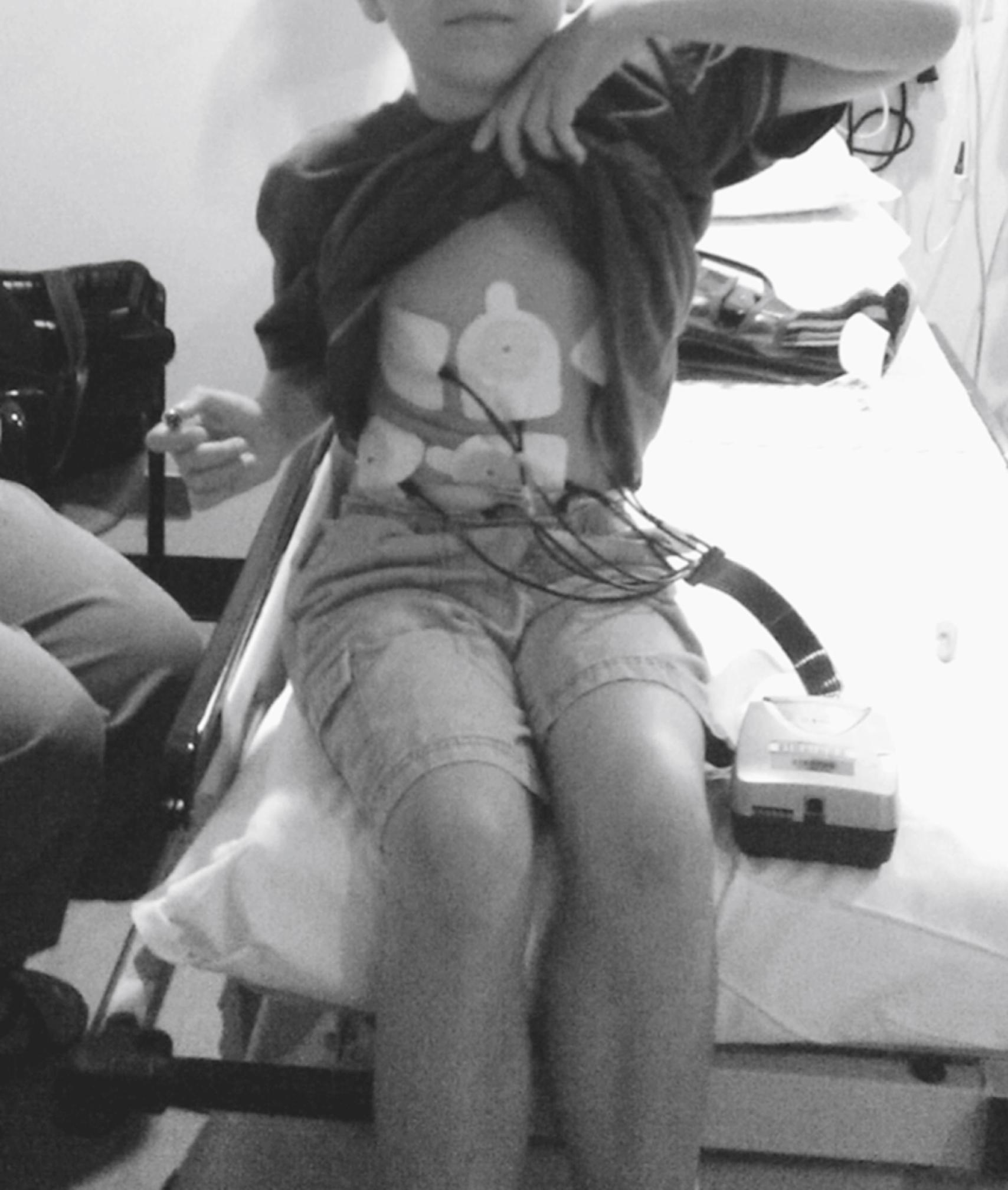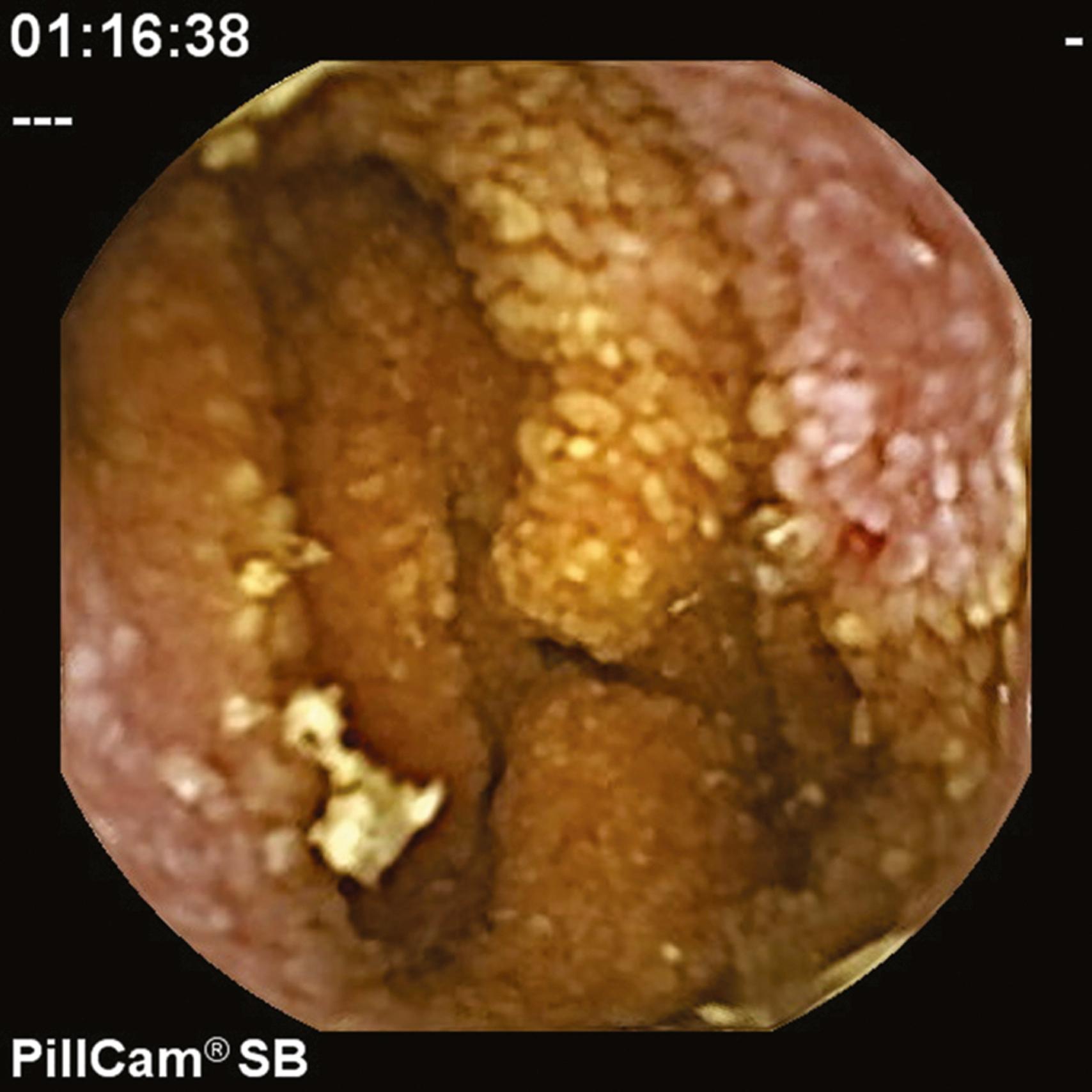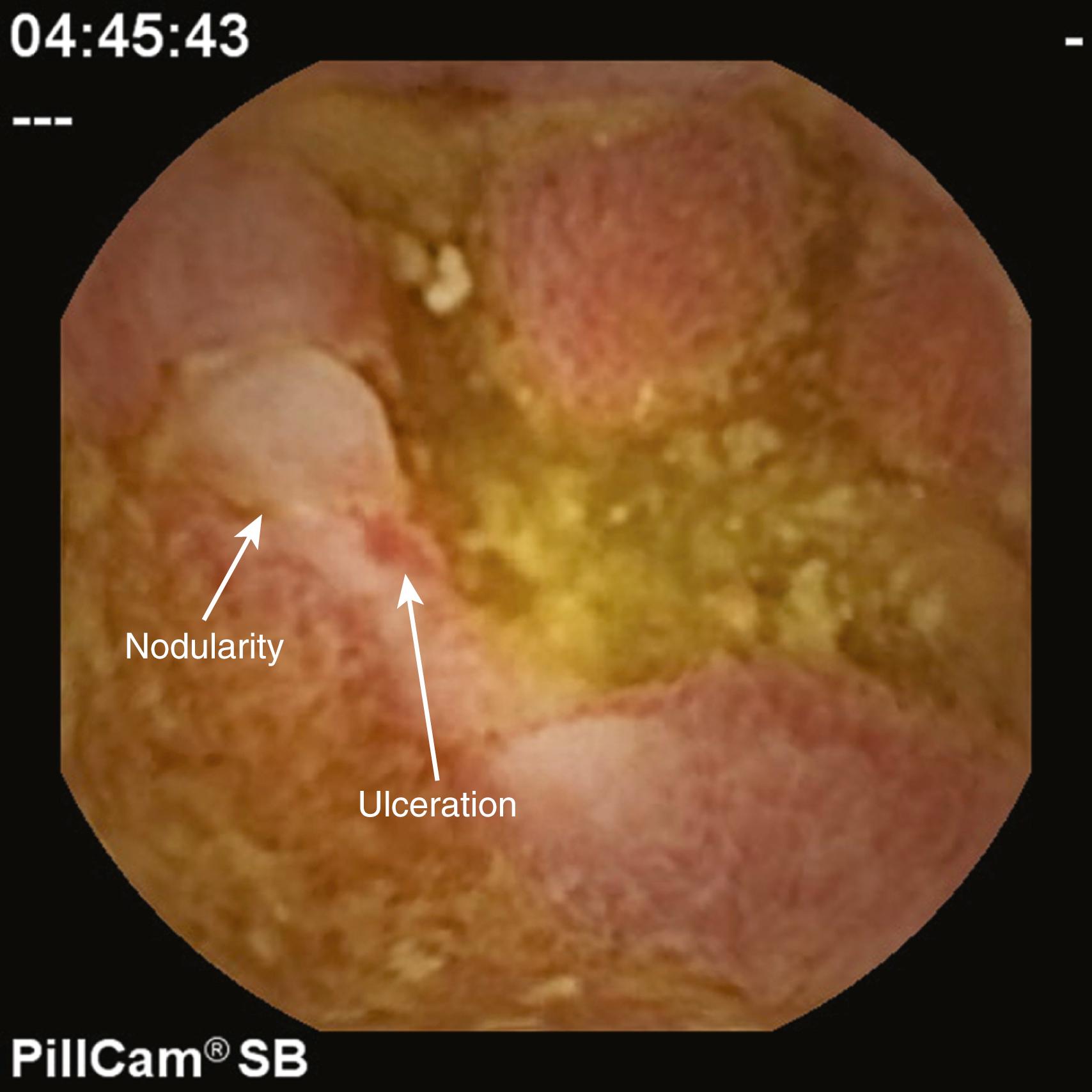Physical Address
304 North Cardinal St.
Dorchester Center, MA 02124
Small bowel video capsule endoscopy (VCE) was introduced in 2001 as a noninvasive means of obtaining high-quality, color endoscopic images from the duodenum to the cecum. Soon thereafter, VCE challenged traditional studies as the preferred method of examining the small bowel mucosa in adults. Early studies suggested superior lesion detection when compared to push enteroscopy and small bowel follow-through or enteroclysis in the evaluation of obscure gastrointestinal bleeding (GIB) and small bowel involvement of Crohn disease. Since those initial reports, VCE has become a widely used tool in both adult and pediatric-aged patients for a number of indications including inflammatory disorders of the small bowel such as Crohn disease and celiac disease, obscure GIB, polyposis syndromes, unexplained growth failure, abdominal pain, and vascular anomalies. Diagnostic yield has been found to be superior to both small bowel follow-through and standard endoscopic investigation in the evaluation of children with suspected small bowel disease. As of January 2014, VCE had been approved by the U.S. Food and Drug Administration (FDA) for use in children 2 years of age and older but it has been reported to be safe even at 8 months of age or for children with a weight of more than 7.9 kg.
The history of the development of the small bowel capsule is fascinating and has been well documented; the technology continues to improve. Although several companies now produce VCE equipment, most clinical and research experience involves the PillCam SB by Given Imaging (Yoqneam, Israel). This system uses a 26-mm by 11-mm capsule containing, among other things, a transmitter, battery, light source, and camera, which takes two pictures per second over a span of up to 12 hours. The images are transmitted by radiotelemetry to a recording device worn by the patient ( Fig. 63.1 ). A computer workstation is then used by the provider to download and review images and to create a report. A similar system called Endocapsule is produced by Olympus using a capsule of identical size (Olympus America Inc. Center Valley, PA, USA). Intromedic Co., Ltd (Seoul, Korea) introduced the MiroCam, which is a slightly smaller (24 × 11 mm) system and the only one that uses electric field propagation to transmit data. The OMOM smart capsule by Chongqing Jinshan Science and Technology Co., Ltd (Chongqing, China), has parameters similar to the MiroCam but is slightly larger. All four devices are FDA approved and available for purchase in the United States. CapsoCam SV-2 (CapsonVision Inc., Saratoga, CA, USA) is the only capsule with onboard flash memory. It uses four cameras to provide a 360-degree panoramic view. This device needs to be retrieved from the stool after passage, and it is not currently FDA approved. Video capsules with double-ended cameras are also available for evaluation of esophagus and colon: PillCam ESO 3 and PillCam Colon 2. Both have mainly been studied in adults. Primary indications for the colon capsule are identification of polyps and colorectal cancer, and for the esophageal capsule, screening for Barrett esophagus and esophageal varices.

Research studies have been done to enable manipulation of VCE in the gastrointestinal tract using external magnet systems, with the purpose of allowing better visualization and possibly therapeutic interventions.
Compared with other methods of small bowel examination, including radiographic evaluation, push enteroscopy, and overtube or balloon-assisted enteroscopy, VCE is easily performed. The capsule has been swallowed by children as young as 4 years of age. However, success of voluntary ingestion may depend more on maturity level and confidence of the child than chronologic age, as many older children and teenagers fail or refuse to swallow the capsule. In patients who are unable to swallow the capsule, endoscopic placement across the pylorus is fairly routine.
Debate continues over optimal timing and what type of preparation is superior before VCE study. Standard instructions often include nothing by mouth for 12 hours before capsule ingestion. Then, 2 hours after capsule ingestion, the patient may take clear liquids. The patient may have a light meal 4 hours after ingestion. The use of a bowel prep with polyethylene glycol the night before the study is now widely recommended. A meta-analysis of adult studies has shown improvement in both visualization and diagnostic yield with this regimen when compared to fasting alone. Polyethylene glycol preparation was superior to sodium phosphate–based regimens as well. The addition of simethicone prior to capsule ingestion has also been shown to improve visualization by reducing air bubbles. In a prospective randomized controlled trial (RCT) evaluating this question in pediatric patients, a regimen of 25 mL/kg (max 1 L) of polyethylene glycol given the night before the procedure, with 20 mL (376 mg) of simethicone 30 minutes before capsule placement, produced significantly better visualization scores but similar diagnostic yield compared to no bowel prep, either agent alone or to higher volumes of polyethylene glycol alone, suggesting that this may be the optimal regimen in pediatric patients.
Before performing VCE studies in children, a fundamental question that must be answered is whether the patient will be able to voluntarily ingest the capsule. A swallowed capsule is preferable and tends to provide cleaner images, as capsule placement in small patients frequently causes mucosal trauma and self-limited bleeding that can confound the study interpretation. As mentioned previously, patients as young as 4 years of age have successfully swallowed the capsule, but children older than age 8 will more reliably succeed. Seidman et al. proposed a trial with candy such as large jellybeans before the study date to predict success.
If a capsule cannot be swallowed, endoscopic placement across the pylorus is usually not a difficult procedure. This has been reported in children using polypectomy snares and Roth Net (US Endoscopy, Mentor, OH, USA) to advance the capsule, , and a simple capsule delivery device for use with standard gastroscopes (AdvanCE, US Endoscopy) is commercially available. Successful use of this device has been reported in children as young as 1.6 years old.
Endoscopic capsule placement can be performed with patients in the supine position, but passage through the posterior pharynx may be facilitated by a left lateral decubitus position. Following esophageal intubation, the next difficulty may be encountered when advancing the capsule through the pylorus. If significant resistance is encountered, careful balloon dilation of the pylorus to a diameter of 11 mm or greater is possible, or a small dose of glucagon will likely lead to pyloric relaxation, permitting passage. Another option is to gently pass a pediatric colonoscope or therapeutic endoscope across the pylorus just before passing the capsule to achieve dilation of the entire upper GI tract. In cases where the capsule cannot pass the pylorus, deposition in the stomach is not optimal, because the chances of it entering the duodenum without assistance are low. After the release of the capsule in the duodenum, it may be helpful to push the capsule as far distally as possible using the endoscope to prevent retrograde migration into the stomach. Prokinetic agents such as erythromycin or metoclopramide may be beneficial as well in preventing retrograde migration after endoscopic placement.
Diagnostic review of VCE studies is technically uncomplicated. The North American Society of Pediatric Gastroenterology, Hepatology, and Nutrition (NASPGHAN) recommends that trainees should interpret 20 VCE under supervision before being considered competent. Although not formally evaluated in pediatrics, this recommendation parallels the American Society for Gastrointestinal Endoscopy (ASGE) recommendations, which include completion of a gastrointestinal endoscopy training program, competence in upper gastrointestinal endoscopy and colonoscopy, and either formal training in capsule endoscopy during gastroenterology fellowship or completion of a hands-on VCE course with review of the first 20 capsule studies by an experienced capsule endoscopist.
Physician review of VCE studies can be time-consuming, and the question has been raised whether the time required is economically or practically beneficial. Viewing practices certainly vary among physicians, but early studies reported small bowel viewing times of 34 to 120 minutes for adult procedures. , , It has been recommended that novice viewers read studies at an image rate of no higher than 12 to 15 frames per second, with experts reading at rates of up to 20 frames per second.
There are a number of indications for small bowel VCE in children. These include evaluation of small bowel mucosa for evidence of Crohn disease, obscure GIB, celiac disease, polyps and tumors, and graft-versus-host disease (GVHD). Other indications include evaluation of unexplained growth failure, abdominal pain, and protein-losing enteropathy or intestinal lymphangiectasia ( Fig. 63.2 ). These indications have been described primarily in retrospective case series and will be discussed individually.

Capsule endoscopy is frequently used in the evaluation of suspected Crohn disease and has been shown to detect small bowel inflammation in patients with otherwise normal evaluations ( Fig. 63.3 ). , In adult patients, VCE has been compared to enteroclysis, small bowel follow-through, and computed tomography (CT) scan and found to be superior in establishing the presence and extent of small bowel inflammation in patients with known or suspected Crohn disease. Based on prospective and retrospective data, VCE has been effective in the evaluation of suspected Crohn disease in children as well and has been shown to influence management decisions and outcomes. , VCE has been prospectively and retrospectively compared to magnetic resonance enterography (MRE) in pediatric Crohn’s, showing similar sensitivity and specificity with the added advantage of picking up subtle lesions missed by MRE but with the disadvantages of missing extraintestinal disease and the risk of capsule retention in case of bowel strictures. , It has been recommended by NASPGHAN as an appropriate procedure when Crohn disease of the small bowel is strongly suspected but cannot be detected by other modalities.

Differentiation of Crohn disease from ulcerative colitis remains clinically challenging at times, but one finding that is useful in this differentiation is significant small bowel mucosal inflammation. Several pediatric studies have concluded that VCE leads to reclassification of inflammatory bowel disease (IBD) from ulcerative colitis or IBD unclassified to Crohn disease. , , VCE may also prove useful as a noninvasive way to document mucosal healing in Crohn disease and to monitor for postoperative recurrence proximal to surgical anastomoses. The use of VCE as first-line evaluation of the small bowel in patients with suspected Crohn disease has been discussed but remains controversial; however, it is clear that VCE in children can be useful in the diagnosis and classification of IBD and may help to improve outcomes by facilitating appropriate choices of therapy.
Obscure GIB is typically defined as GIB with a source not identified by traditional upper and lower endoscopy and usually requires investigation of the small bowel. Soon after the introduction of small bowel VCE, it became clear that the color images it provided were superior to radiographic evaluation in cases of suspected small bowel bleeding. Subsequently, it was determined that VCE had higher diagnostic yield when compared to push enteroscopy, , likely due to its ability to view a greater length of small bowel mucosa, but it provided no therapeutic benefit. Based on these results, and lack of availability of enteroscopy at many centers, VCE is currently recommended as the first-line investigation for adult patients with obscure GIB. No prospective studies have been performed in children, but case reports and small retrospective series support the use of VCE in pediatric populations for this indication, reporting diagnostic yields of 62% to 100%, higher when it is performed within one week of onset of symptoms. , A recent randomized controlled study in adults, comparing early VCE (ingested soon after admission to the hospital) with standard of care in the approach to nonhematemesis GIB, showed that a bleeding source was successfully localized in 64.3% of the patients in the early VCE group compared with 31.3% in the other group. The capsule used in this study was an Olympus EC-S10 with a real-time viewer activated on the recorder at time of ingestion.
Become a Clinical Tree membership for Full access and enjoy Unlimited articles
If you are a member. Log in here